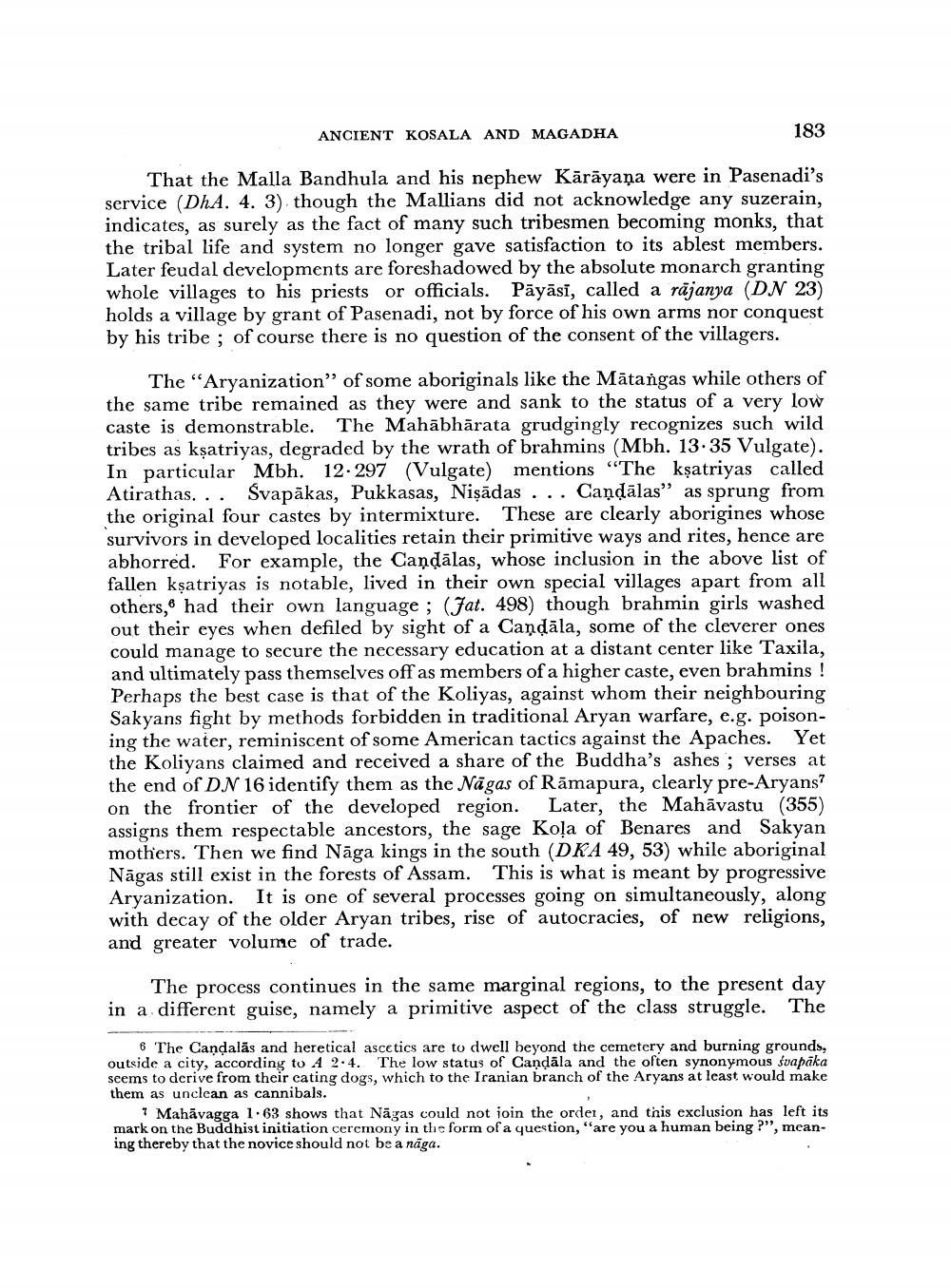Book Title: Ancient Kosala And Mmagadha Author(s): Dharmanand Kosambi Publisher: D D Kosambi View full book textPage 4
________________ ANCIENT KOSALA AND MAGADHA 183 That the Malla Bandhula and his nephew Kārāyana were in Pasenadi's service (DHA. 4. 3) though the Mallians did not acknowledge any suzerain, indicates, as surely as the fact of many such tribesmen becoming monks, that the tribal life and system no longer gave satisfaction to its ablest members. Later feudal developments are foreshadowed by the absolute monarch granting whole villages to his priests or officials. Pāyāsi, called a rajanya (DN 23) holds a village by grant of Pasenadi, not by force of his own arms nor conquest by his tribe ; of course there is no question of the consent of the villagers. ained as they whārata grudgingly Müh. 13.35 V The “Aryanization” of some aboriginals like the Mātangas while others of the same tribe remained as they were and sank to the status of a very low caste is demonstrable. The Mahābhārata grudgingly recognizes such wild tribes as ksatriyas, degraded by the wrath of brahmins (Mbh. 13.35 Vulgate). In particular Mbh. 12. 297 (Vulgate) mentions “The kșatriyas called Atirathas... Svapākas, Pukkasas, Nişādas ... Candālas” as sprung from the original four castes by intermixture. These are clearly aborigines whose survivors in developed localities retain their primitive ways and rites, hence are abhorred. For example, the Candālas, whose inclusion in the above list of fallen kșatriyas is notable, lived in their own special villages apart from all others, had their own language ; (Jat. 498) though brahmin girls washed out their eyes when defiled by sight of a Candāla, some of the cleverer ones could manage to secure the necessary education at a distant center like Taxila, and ultimately pass themselves off as members of a higher caste, even brahmins ! Perhaps the best case is that of the Koliyas, against whom their neighbouring Sakyans fight by methods forbidden in traditional Aryan warfare, e.g. poisoning the water, reminiscent of some American tactics against the Apaches. Yet the Koliyans claimed and received a share of the Buddha's ashes ; verses at the end of DN 16 identify them as the Nāgas of Rāmapura, clearly pre-Aryans? on the frontier of the developed region. Later, the Mahāvastu (355) assigns them respectable ancestors, the sage Koļa of Benares and Sakyan mothers. Then we find Nāga kings in the south (DKA 49, 53) while aboriginal Nāgas still exist in the forests of Assam. This is what is meant by progressive Aryanization. It is one of several processes going on simultaneously, along with decay of the older Aryan tribes, rise of autocracies, of new religions, and greater volume of trade. The process continues in the same marginal regions, to the present day in a different guise, namely a primitive aspect of the class struggle. The 6 The Candalas and heretical ascetics are to dwell beyond the cemetery and burning grounds, outside a city, according to A 2.4. The low status of Candāla and the often synonymous svapāka seems to derive from their cating dogs, which to the Iranian branch of the Aryans at least would make them as unclean as cannibals. ? Mahāvagga 1.63 shows that Nägas could not join the order, and this exclusion has left its mark on the Buddhist initiation ceremony in the form of a question, "are you a human being ?", meaning thereby that the novice should not be a nāga.Page Navigation
1 2 3 4 5 6 7 8 9 10 11 12 13 14 15 16 17 18 19 20 21 22 23 24 25 26 27 28 29 30 31 32 33 34
